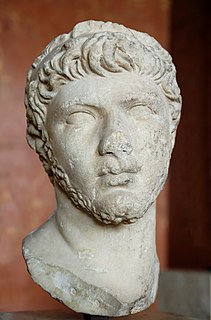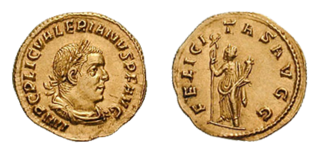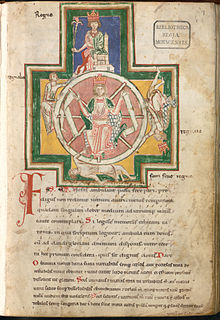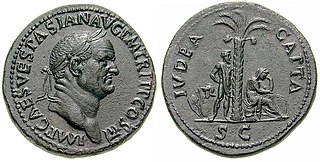
Ptolemy of Mauretania was the last Roman client king and ruler of Mauretania for Rome. He was a member of the Berber Massyles tribe of Numidia; via his mother Cleopatra Selene II, he was also a member of Egypt's Ptolemaic dynasty.

In ancient Roman religion, Ceres was a goddess of agriculture, grain crops, fertility and motherly relationships. She was originally the central deity in Rome's so-called plebeian or Aventine Triad, then was paired with her daughter Proserpina in what Romans described as "the Greek rites of Ceres". Her seven-day April festival of Cerealia included the popular Ludi Ceriales. She was also honoured in the May lustratio of the fields at the Ambarvalia festival, at harvest-time, and during Roman marriages and funeral rites.
In ancient Roman religion, Aeternitas was the divine personification of eternity. She was particularly associated with Imperial cult as a virtue of the deified emperor (divus). The religious maintenance of abstract deities such as Aeternitas was characteristic of official Roman cult from the time of the Julio-Claudians to the Severans.

In ancient Roman culture, felicitas is a condition of divinely inspired productivity, blessedness, or happiness. Felicitas could encompass both a woman's fertility, and a general's luck or good fortune. The divine personification of Felicitas was cultivated as a goddess. Although felicitas may be translated as "good luck," and the goddess Felicitas shares some characteristics and attributes with Fortuna, the two were distinguished in Roman religion. Fortuna was unpredictable and her effects could be negative, as the existence of an altar to Mala Fortuna acknowledges. Felicitas, however, always had a positive significance. She appears with several epithets that focus on aspects of her divine power.
In ancient Roman religion, Spes was the goddess of hope. Multiple temples to Spes are known, and inscriptions indicate that she received private devotion as well as state cult.

In ancient Roman religion, Roma was a female deity who personified the city of Rome and more broadly, the Roman state. Her image appears on the base of the column of Antoninus Pius.

Annia Galeria Faustina, sometimes referred to as Faustina I, was a Roman empress and wife of the Roman emperor Antoninus Pius. The emperor Marcus Aurelius was her nephew and later became her adopted son, along with Emperor Lucius Verus. She died early in the principate of Antoninus Pius, but continued to be prominently commemorated as a diva, posthumously playing a prominent symbolic role during his reign.

In ancient Roman religion, Concordia is the goddess who embodies agreement in marriage and society. Her Greek equivalent is usually regarded as Harmonia, with musical harmony a metaphor for an ideal of social concord or entente in the political discourse of the Republican era. She was thus often associated with Pax ("Peace") in representing a stable society. As such, she is more closely related to the Greek concept of homonoia (likemindedness), which was also represented by a goddess.

Fortuna was the goddess of fortune and the personification of luck in Roman religion who, largely thanks to the Late Antique author Boethius, remained popular through the Middle Ages until at least the Renaissance.

Volusianus, also known as Volusian, was a Roman Emperor from November 251 to August 253. His father, Trebonianus Gallus, became Roman Emperor after being elected in the field by the legion, following the deaths of the previous co-emperors Decius and Herennius Etruscus. Trebonianus Gallus raised Hostilian, the son of Decius, to augustus, making him his co-emperor in June 251. Volusianus was elevated to caesar in the same month. After the death, or murder, of Hostilian in November 251, Volusianus was raised to augustus, co-ruling with his father. The short reign of Trebonianus Gallus and Volusianus was notable for the outbreak of a plague, which is said by some to be the reason for Hostilian's death, the invasion of the Sasanian Empire, and the raids of the Goths. Volusianus was killed alongside his father in August 253 by their own soldiers, who were terrified of the forces of the usurper Aemilian which were marching towards Rome.

Sol Invictus was the official sun god of the later Roman Empire and a patron of soldiers. On 25 December AD 274, the Roman emperor Aurelian made it an official cult alongside the traditional Roman cults. Scholars disagree about whether the new deity was a refoundation of the ancient Latin cult of Sol, a revival of the cult of Elagabalus, or completely new. The god was favored by emperors after Aurelian and appeared on their coins until the last third-part of the reign of Constantine I. The last inscription referring to Sol Invictus dates to AD 387, and there were enough devotees in the fifth century that the Christian theologian Augustine found it necessary to preach against them.

In ancient Roman religion, a votum, plural vota, is a vow or promise made to a deity. The word comes from the past participle of the Latin verb voveo, vovere, "vow, promise". As the result of this verbal action, a votum is also that which fulfills a vow, that is, the thing promised, such as offerings, a statue, or even a temple building. The votum is thus an aspect of the contractual nature of Roman religion, a bargaining expressed by do ut des, "I give that you might give."

The Augustalia, also known as the Ludi Augustales, was a festival celebrated October 12 in honor of Augustus, the first Roman emperor. It was established in conjunction with an altar to Fortuna Redux to mark the return of Augustus from Asia Minor to Rome in 19 BC. The pontiffs and Vestals conducted sacrifices, and the date became a holiday (feriae) on the official religious calendar of Rome.

In ancient Roman religion, Annona is the divine personification of the grain supply to the city of Rome. She is closely connected to the goddess Ceres, with whom she is often depicted in art.

The Imperial cult of ancient Rome identified emperors and some members of their families with the divinely sanctioned authority (auctoritas) of the Roman State. Its framework was based on Roman and Greek precedents, and was formulated during the early Principate of Augustus. It was rapidly established throughout the Empire and its provinces, with marked local variations in its reception and expression.

The profectio was the ceremonial departure of a consul in his guise as a general in Republican Rome, and of an emperor during the Imperial era. It was a conventional scene for relief sculpture and imperial coinage. The return was the reditus and the ceremonial reentry the adventus.

Judaea Capta coins were a series of commemorative coins originally issued by the Roman Emperor Vespasian to celebrate the capture of Judaea and the destruction of the Jewish Second Temple by his son Titus in 70 CE during the First Jewish Revolt. There are several variants of the coinage. The reverse of the coins may show a female seated right in an attitude of mourning at the base of a palm tree, with either a captive bearded male standing left, with his hands bound behind his back, or the standing figure of the victorious emperor, or the goddess Victoria, with a trophy of weapons, shields, and helmets to the left.

The Sanctuary of the Three Gauls (Tres Galliae) was the focal structure within an administrative and religious complex established by Rome in the very late 1st century BC at Lugdunum. Its institution served to federalise and Romanise Gallia Comata as an Imperial province under Augustus, following the Gallic Wars of his predecessor Julius Caesar. The distinctively Gallo-Roman development of the Imperial sanctuary and its surrounding complex are well attested by literary, epigraphic, numismatic and archaeological evidence.
A gubernaculum in classical references describes a ship's rudder or steering oar. Gubernaculum, like cornucopia, is really a Latin word. The English word government is related to it. The Old English word governail and the Scots word gouernaill are both derived from it.














